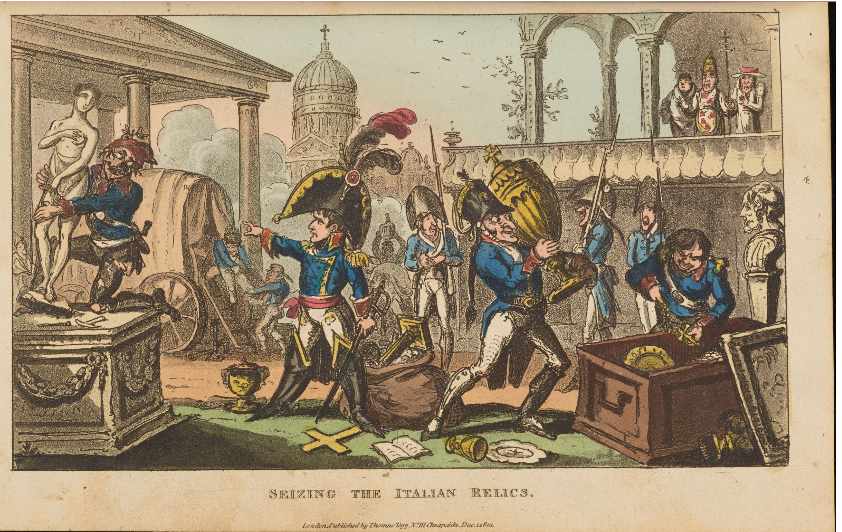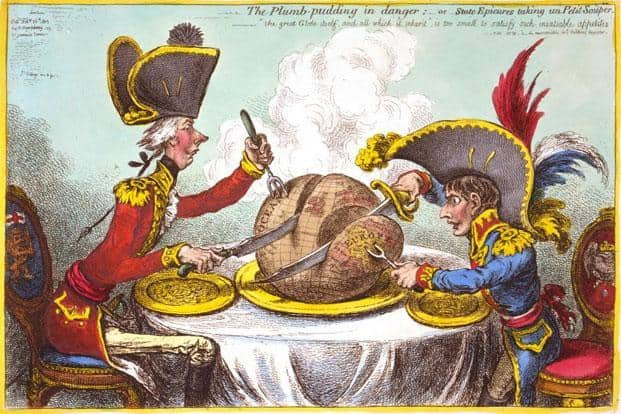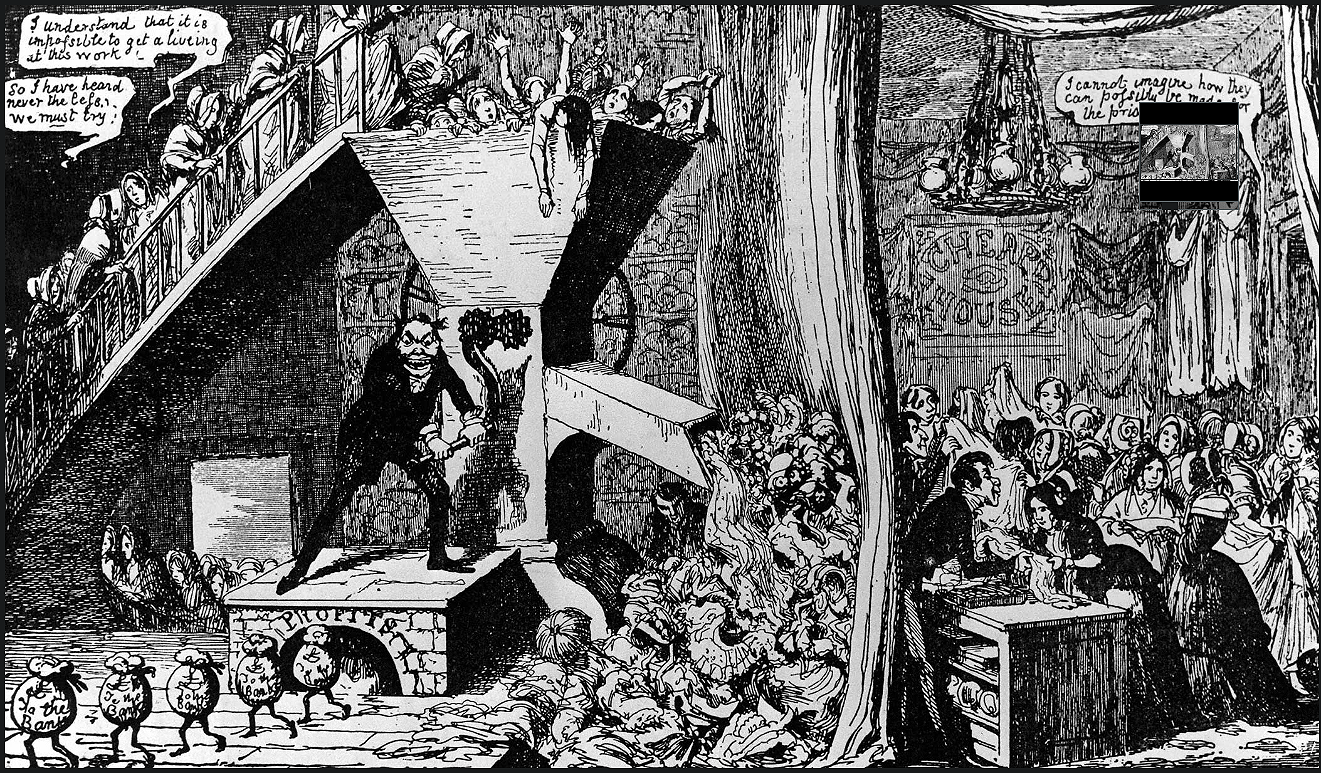With this research point, the aim was to take a selection of past satirical cartoons and see if they could be successfully reworked for a contemporary audience.
Introduction
I’ve always considered satire a very clever and humorous format for poking fun at the establishment and it’s frequent absurdity, even more so the British Parliament and the way it’s often perceived as stuffy, draconian and out of touch with everyday life. It’s concept these days is enduring given the many other forms of delivery with which satire perhaps could be presented. Even though it’s likely to be taken for granted in newspapers, there will have been a time when producing satire which ribbed the establishment in certain countries could have landed the artist in trouble : in fact it’s happened even in modern times. It’s therefore ironic that satire should turn victim in these situations.
It’s more or less a given that politicians will be a most popular subject for satire (in fact it’s almost like an unwritten statute!), they prove far too easy on a daily basis as most of them have a seemingly endless supply of skeletons in their often luxurious closets, or they present one too many public facing blunders where the public wait with pack mentality to rip them apart. Imagine if every person in any country was able to draw how they felt sardonically about their politicians : it’d make for an interesting alternative to the census, as well as a visual representation of how content a society was.
It’s interesting that in past times when literacy was still mostly confined to the upper echelons of society, the simplest way to entertain and inform people of contemporary events was to present them with chap books or pamphlets, (assuming they even had the spare funds for such a luxury if they needed to be purchased) featuring illustrations which depicted current affairs in an allegorical fashion : that there was text accompanying the imagery may not have mattered to illiterate classes as they would have still been capable of enjoying the representations of statesmen, politicians, Royalty or countries. I expect the less text there was accompanying satirical imagery of the day, the more of a reliance there would have been on making the image read easier visually. This is something which was and has been capitalized on since language and imagery came about, from cave painting when there was no concept of language or lexicon through to the middle ages when churches depicted heaven and hell via frescos as a warning to their often illiterate flock.
contemporary comparisons
For a first comparison where a past satirical illustration could be re-worked, I’d like to try this image by George Cruickshank, Seizing the Italian Relics an image which depicts Napoleon overseeing the sack of Italian art during the Northern invasion by France under his command.

With some pushing, I believe this could be re-worked into either an image which :
A). Depicts Russia’s President Putin sacking Ukraine’s sovereignty, (perhaps a bear, the universal metaphor for Russia crossing the border line into Ukrainian territory while picking cherries, the Ukrainian national fruit (which is a metaphor for Ukraine’s oil, gas and mineral reserves which Russia thinks it has a claim to through Putin’s imperialistic narrative). There could be an element of the Ukrainian national symbol, the blue shield and gold trident worked into this too.
B). Depicts China’s intention with similar aspirations upon Taiwan, using the visual metaphor of China as a dragon. As Taiwan manufactures around 90% of the world’s advanced processing chips for computers, China would pretty much control the West’s chip supply if they took over Taiwan and therefore probably their ability to stealth Western hardware, the argument being that their intention to overthrow the island isn’t merely one of imperialistic domination.
C). Depicts China’s or Russia’s perceived acquisition of Africa’s mineral resources for their economies.
D). Depicts any diversion of vital funding in the UK from one public sector to another, for example pensions being raided at the expense of something else, or the NHS being raided at the expense of something else (the something else usually what is current at the time, and often something of lesser, trivial or relatively absurd importance where the needs it diminished in the face of the crisis).
This is a very evergreen image in it`s presentation and subject representation, it can be applied to lots of situations and it can also be metaphorically adjusted quite easily. The sacking metaphor is nothing new, but the presentation is clever and it reads easily. When you start adding in imagery such as nation icons (Russian bear, American Eagle or Uncle Sam, Chinese dragon etc.) you can start to see the potential of this image.
While I was looking at National personifications, I found a really quick and useful guide here. I discovered quite a few surprising ones in there, and to be fair I apart from the popular ones which are often depicted in satire such as Britannia, the Russian bear and so on, I’d have found it a challenged to think of many more really.
For the next image, I chose a James Gillray illustration called The plumb pudding in danger. This is a very famous satirical image which is well known, it depicts the British Prime minister William Pitt and Napoleon Bonaparte carving up the ocean and Europe represented as a giant plum pudding, each with imperial intentions.

Along the same vein as the previous Cruickshank image, this could be applied to just about any point in history including the current political climate wherever a conflict is playing out at any point in the world between superpowers (which is pretty much anytime in history unfortunately). There is a more specific thread here in the actual image, as Pitt was intent on taking naval superiority of the oceans to the west of Britain while Bonaparte was intent on a conquest of Europe, Britain was left in the centre : but generally speaking, the visual metaphor could be adjusted to the narrative of any country or region involved, although the plumb or plum pudding here is represented as a quintessentially British dessert which is representative of the British Empire so that aspect of the image is somewhat trickier to rework.
A). Pitt could be substituted for Biden, Bonaparte for Putin in a straight-up cold war conquest image, the pudding being a turkey to symbolize the American thanksgiving. This could be adjusted to make the caricatures look as though they are hacking at the subject matter, making the image read more readily for a subject related to hacking.
B). Pitt could represent NATO, Bonaparte as Putin again, Ukraine could be the centre subject left in Limbo as both fight for larger slices. In this imperial struggle, Putin could quite easily be fashioned into a Peter the Great character, wearing plumage and armour with a sabre (even Napoleon’s diminutive stature fits the bill here!). NATO on the other hand could be represented as Pax the Roman goddess of Peace, or Eirene the Greek goddess of peace.
The visual metaphor here is a fine all rounder which can be adapted in lots of different ways to a variety of situations, substituting the plum pudding for a country shaped cake or cut of meat would work the same yet could describe something occurring domestically as opposed to globally. Adding more characters with some consideration to the composition would allow for more diners to be introduced to the meal.
For this final image, I chose another George Cruickshank illustration, entitled Tremendous Sacrifice!. This is a commentary on sweatshops, the workhouse poor can be seen climbing in a perpetual uphill struggle signified by the staircase, the accompanying speech bubbles even reinforcing their endless and seemingly pointless plight stating that even though they understand it’s impossible to earn a living at their work, they must try nevertheless through hard toil. Below them is a greedy businessman, turning the handle on a huge meat grinder into which they workers fall, below them the fruits of the workers labour are transformed into bags of cash which have To The Bank written on them, as they pass from a tunnel marked Profits. From the side of the grinder, what appear to be cheap garments made by the workers are proffered in a cheap house for sale, with one of the customers stating “I cannot imagine how they can possibly be made for the price”.

Another strong metaphorical image, this could perhaps depict some of the following :
A). A certain popular far eastern fast fashion company has been slammed for it’s sweatshop culture, this image could be reworked for a contemporary reference in this way, along with another particularly large online shopping company which has been linked to unethical employment culture. The statements are virtually true, sadly even in these modern times.
B). This could apply to the human trafficking trade, the workers replaced by immigrants seeking asylum while the profiteer turns the wheel of the grinder, the profits could be marching to the right hand side of the image and the cheap house replaced by a criminal gang house piled with cash.
C). In the same vein, this could represent Mexican drug cartels, the people climbing the stairs could be addicts, the cash bags the cartel profits and the by product to the right, the publicly imperceptible cash flowing to the US into banks to be laundered, while the cheap house is replaced with a respectable looking bank with customers handling cash at a branch counter.
This has an equally strong visual metaphor as the previous images. The nature of this one is particularly grim with visceral overtones, so I was particularly hard pressed to even suggest a positive connotation to this one. To be honest all three are quite sober and thought provoking in their subject matter, unfortunately this seems to be the nature of modern news these days : it rarely reports on much that is positive, which Is likely a result of the state of the world and the worst aspects of the human condition. A vast majority of people do have a predisposition to morbid fascination, revelling in misfortune at the expense of others and news corporations achieve the very same thing every day as satire, but without the sardonic wit.
This quote from C.Joybell.C. says it all :
“What kind of a world do we live in, when the good are taken advantage of by the bad, while the bad have platforms to talk about good things. Bad people are never bad in their own eyes, while good people are never good enough in their own eyes. This is the kind of world that we live in.”
Conclusion
Satirical illustration is a particularly challenging area of illustration : while there’s a reliance on metaphor it also requires a good awareness of bleeding edge events, and a quick turnaround if they’re to be used in something like newspapers. A slower paced approach could probably be achieved by taking in monthly or annual events in a recap, or ongoing events such as war, unpleasant as it may be in terms of subject matter.
I found this an interesting exercise, the discovery that satirical illustrations from the past have relevance not only currently, but for other periods in history past. This is an intriguing thread in itself, as there’re many facets of art which are recycled or become relevant in this way through being cyclic. Fashions are the same… music to some degree.. satire is up there on it’s own though as it’s not particularly zeitgeist based, but more fluid and evolving with current events.
Image References:
https://commons.wikimedia.org/wiki/File:George_Cruikshank,_Seizing_the_Italian_Relics,_1815.jpg
https://en.wikipedia.org/wiki/The_Plumb-pudding_in_danger
https://artsandculture.google.com/asset/kQFs3ULctLotpw?hl=en